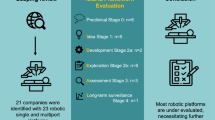Abstract
Percutaneous coronary intervention (PCI) has undergone a remarkable evolution over the past 25 years. Initially, the procedure was limited to relatively straightforward lesions and was associated with significant risk and unpredictable long-term efficacy. With the incorporation of new technologies such as stents, the safety and efficacy of the procedure has improved dramatically. However, the fundamental way in which the procedure is performed has changed little since the time of Gruntzig’s first successful case. Cumulative exposure to ionizing radiation, orthopedic injuries resulting from wearing shielding aprons, and fatigue from standing for hours at the table have made the catheterization laboratory a “high-risk workplace” for the interventional cardiologist. Robotic-assisted PCI was developed to allow the operator to precisely manipulate angioplasty guidewires, balloons, and stents from a radiation-shielded cockpit. A small first-in-man study demonstrated that PCI can be performed with robotic assistance. The pivotal Percutaneous Robotically Enhanced Coronary Intervention Study trial is currently enrolling patients and evaluating the safety and efficacy of the CorPath® robotically assisted PCI system.




Similar content being viewed by others
References
Gruntzig, A. R., Senning, Ã. K., & Siegenthaler, W. E. (1979). Nonoperative dilatation of coronary-artery stenosis. New England Journal of Medicine, 301(2), 61–68.
Detre, K., Holubkov, R., Kelsey, S., Cowley, M., Kent, K., Williams, D., et al. (1988). Percutaneous transluminal coronary angioplasty in 1985 “1986 and 1977 “1981. New England Journal of Medicine, 318(5), 265–270.
Serruys, P. W., Strauss, B. H., Beatt, K. J., Bertrand, M. E., Puel, J., Rickards, A. F., et al. (1991). Angiographic follow-up after placement of a self-expanding coronary-artery stent. New England Journal of Medicine, 324(1), 13–17.
Moses, J. W., Leon, M. B., Popma, J. J., Fitzgerald, P. J., Holmes, D. R., O’Shaughnessy, C., et al. (2003). Sirolimus-eluting stents versus standard stents in patients with stenosis in a native coronary artery. New England Journal of Medicine, 349(14), 1315–1323.
Duran, A., Vano Echeverri, N. K., Cabrera, M. C., & Miller, M. R. (2011). Retrospective evaluation of lens injuries and dose: RELID Study. Journal of the American College of Cardiology, 57, E1951.
Rehani, M. M. (2007). Training of interventional cardiologists in radiation protection-the IAEA’s initiatives. International Journal of Cardiology, 114, 256–260.
US Food and Drug Administration (FDA). Initiative to reduce unnecessary radiation exposure from medical imaging. February 2010. Available at http://www.fda.gov/downloads/Radiation-EmittingProducts/RadiationSafety/RadiationDoseReduction/UCM200087.pdf.
Khalil, T. M., Abdel-Moty, E. M., & Rosomoff, H. L. (1993). Ergonomics. In Back pain: a guide to prevention and rehabilitation (p. 100). New York: Van Nostrand Reinhold.
Ross, A. M., Segal, J., Borenstein, D., Jenkins, E., & Cho, S. (1997). Prevalence of spinal disc disease among interventional cardiologists. American Journal of Cardiology, 79, 68–70.
Kelsey, J. L., Githens, P. B., Walter, S. D., Southwick, W. O., Weil, U., Holford, T. R., et al. (1984). An epidemiologic study of acute prolapsed cervical intervertebral discs. Journal of Bone and Joint Surgery, 66A, 907–914.
Beyar, R., Gruberg, L., Deleanu, D., Roguin, A., Almagor, Y., Cohen, S., et al. (2006). Remote-control percutaneous coronary interventions: concept, validation, and first-in-humans pilot clinical trial. Journal of the American College of Cardiology, 47, 296–300.
Granada, J. F., Delgado, J. A., Uribe, M. P., Fernandez, A., Blanco, G., Leon, M. B., et al. (2001). First-in-human evaluation of a novel robotic-assisted coronary angioplasty system. JACC: Cardiovascular Interventions, 4, 460–465.
Author information
Authors and Affiliations
Corresponding author
Rights and permissions
About this article
Cite this article
Carrozza, J.P. Robotic-Assisted Percutaneous Coronary Intervention—Filling an Unmet Need. J. of Cardiovasc. Trans. Res. 5, 62–66 (2012). https://doi.org/10.1007/s12265-011-9324-9
Received:
Accepted:
Published:
Issue Date:
DOI: https://doi.org/10.1007/s12265-011-9324-9




